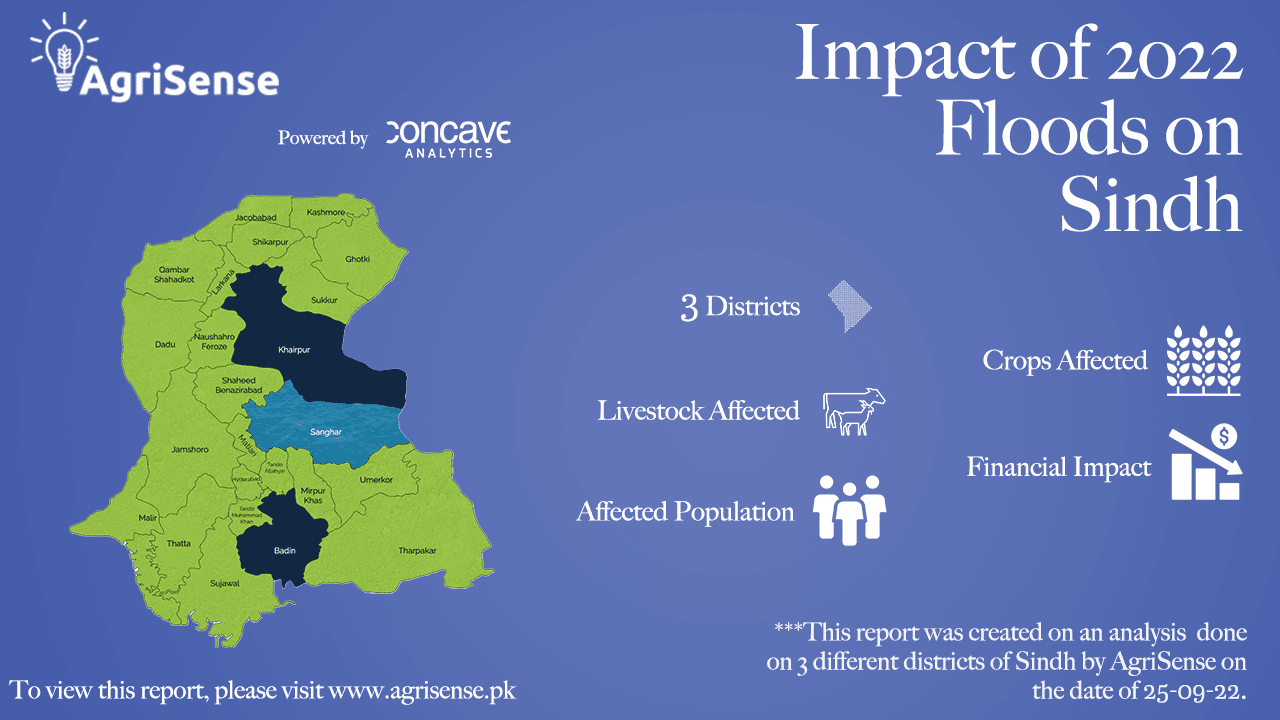In June 2022, flash flooding and torrential rains began threatening the welfare, progression, and prosperity of the agricultural sector, which is the backbone of our national economy and food security.
The unprecedented and unrelenting rainfall and flooding continued, worsening the already fragile humanitarian and economic crisis. According to the UNHCR Supplementary Appeal, as of 23 September 2022, 33 million people were affected, and half a million displaced.
AgriSense, powered by Concave Analytics, is a solution-oriented hub that is driven by its goal to address Pakistan’s agricultural concerns through the technical and analytical skills of research and data accumulation.
In light of these catastrophic events, AgriSense utilized its extensive database, cutting-edge technology, subject matter expertise, and latest modeling techniques to produce an extensive and comprehensive report on the damage caused by the floods of 2022.
The report focuses on three regions of Sindh in particular, Badin, Khairpur, and Sanghar, and presents a holistic analysis that discusses the crop losses, farmlands in danger, and affliction on livestock.
The report developed also communicates the economic losses and financial strains that have struck the agriculture sector along with the challenges faced by the rural population of Sindh.
The crops of interest in this report include Cotton, Rice, Dates, Sugarcane, Jowar, Bajra, Maize, Banana, Onions, Potato, and Tomato.
Given the nation’s top cash crops are wheat, sugarcane, cotton, and rice, the province of Sindh has a commendable contribution of 42% to rice production, 23% to cotton production, and 31% to sugar production in our nation.
5 million hectares of land is dedicated to the agricultural ecosystem but according to AgriSense’s findings, 10.8 million people from these regions are affected, and 3.6 million acres of cropland have been damaged.
Furthermore, the report presents a detailed overview of the livestock sector and its vitality to the agriculture unit of Pakistan.
Livestock has a 61.89% share in the agriculture sector and 14.04% in the GDP of Pakistan, providing employment and rural livelihood to 8 million families however the cataclysmic floods have killed 1.1 million livestock.
AgriSense’s findings delve into specific figures and analysis in terms of region and animal, providing insights related to the age and type of animals at risk.
Finally, the report concludes with an evaluation of the financial losses incurred as a consequence of this natural calamity.
The broad realm of discussion touches on crucial long-term and short-term challenges for the 11.9 million people affected by these floods, including the risk of pushing farmers into debt traps, the negative impact on insurance companies, unemployment, and the long road to rehabilitation that will require substantial and stable economic funding plans.
AgriSense, at its core, is a brand that strives to provide quality research data and detailed reports to help you stay up to date with the latest facts, figures, statistics, and trends. Its model works from the ground up, from collecting data, to transforming it into customized evaluation.
To avail AgriSense services, or for more information, please visit their website. To download the report ‘Impact of Floods 2022 in Sindh’, click here.





















